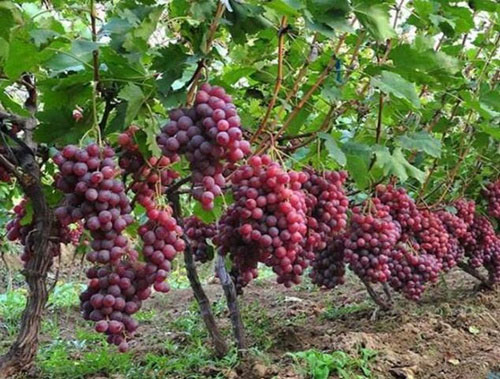Understand the effects of various fertilizers and master the techniques of fertilizing grapes
VIEWS: times Release Date:2020-12-18
Grape fertilization is the same as other fruit trees, requiring elements such as N, P, K, Ca, and trace elements such as Zn, B, and Mn. If you want to use fertilizer well, you must know the role of various fertilizers.

1. Nitrogen (N):
Insufficient nitrogen supply prevents grape plants from growing normally. Under proper nitrogen conditions, the grapes will sprout neatly, pollination, fertilization, and fruit setting are good, which not only guarantees high yield in the year, but also good fruit quality, which also affects the yield of the following year.
In the fertilization of grapes: First, avoid the large-scale application of organic fertilizers and chemical fertilizers based on nitrogen fertilizers, which will cause the imbalance of fertilizer ratio and the adverse symptoms of excessive nitrogen fertilizer. Therefore, the amount of nitrogen fertilizer used and when to apply nitrogen fertilizer must be based on the fertility of the land and the vigor of the grape trees.
2. Phosphorus (P):
P is the main component of nucleoprotein, phospholipid, and nucleic acid. It mainly exists in fast-growing parts, such as flowers and seeds. All organs of grape plants contain phosphorus. Adequate supply of phosphorus is conducive to the flowering and fruit setting of grapes. .
3. Potassium (K):
Grapes are potassium-loving plants. Potassium plays a major role in photosynthesis and sugar transport. The important effect of potassium on grapes is to promote the ripening of berries, improve the quality of berries, increase the sugar content of the berries, promote the coloring of berries and the formation of aromatic substances, and increase the wine yield.
4. Zinc (Zn):
Zn is involved in the synthesis of chlorophyll and auxin. In zinc deficiency, the new shoots have short internodes, small leaves and chlorosis, and a large number of seedless small fruits are formed on the ears, which are often green and hard. Small leaves and small fruits are the main characteristics of zinc deficiency.
5. Boron (B):
B is a trace element, boron affects the function of enzymes, can promote flower fertilization and fruit setting, can promote sugar transport, and reduce deformed fruits.
6. Calcium (Ca):
Ca is a component of cell wall and intercellular layer, and it is also abundant in vacuoles. When calcium is lacking, it affects the normal function of cells. In grape plants, calcium is mainly accumulated in mature organs, but the growth and development of tissues also require a large amount of calcium. It is beneficial to the development and absorption of roots, and there are symptoms of nitrogen deficiency when calcium is lacking.
7. Iron (Fe):
Fe is involved in the composition of a variety of oxidoreductases and participates in the redox effect in cells. Iron deficiency leads to yellowing of grape plants and chlorosis of the leaves. However, unlike magnesia chlorosis, the first manifestation is that the top young leaves are fully yellowed, and only the veins remain green.
8. Magnesium (Mg):
Mg is an important component of chlorophyll and is closely related to photosynthesis. Magnesium mainly exists in active young tissues and organs in grape plants. When magnesium is deficient, the metabolism of phosphorus is poor, the top of the new shoots is water-soaked, the leaves are chlorosis and yellow, only the veins are green, and the fruit setting rate and fruit weight decrease.
Previous : Which organic fertilizer is most suitable for "orchard" use?
Next : Best NPK fertilizer for Squash
Latest News
- The company overcame difficulties and won a "good start" in the first quarter ...2022-03-28
- Safe Production ...2022-03-28
- first-line collection ...2022-03-26
- Huaqiang News ...2022-03-26
- Huaqiang Chemical Strong Agriculture Project ...2022-03-25
- huaqiang news ...2022-03-24
- winning unit ...2022-03-22
- Huaqiang News ...2022-03-21
Related Information
- The best fertilizers for fruits and crops ...2020-05-26
- Huaqiang Chemical Group NPK fertilizer pdf ...2020-04-01
- Humic Acid Fertilizer ...2019-12-31
- Bulk Blending Fertilizer ...2019-12-27
- Water Soluble Fertilizer ...2019-12-08
- NPK Fertilizer ...2019-12-02
- Potassium Sulfate Fertilizer ...2019-11-30
- Urea Fertilizer ...2019-11-21
MESSAGE
Our sales staff will be the first time to get in touch with you,to provide you with the latest price.
-
Chemical Products
-
Compound fertilizer
-
Contact Us
Huaqiang Chemical Group Stock Co.,Ltd.
No.1 Jinping Avenue, Dangyang , Hubei , China
Http://www.hq-chemical.com
info@hq-chemical.com
Tel:+86 717 3431866
Mobile: +86 18627120543
© Copyright 2021 Huaqiang Chemical Group Stock Co.,Ltd. All Rights Reserved



